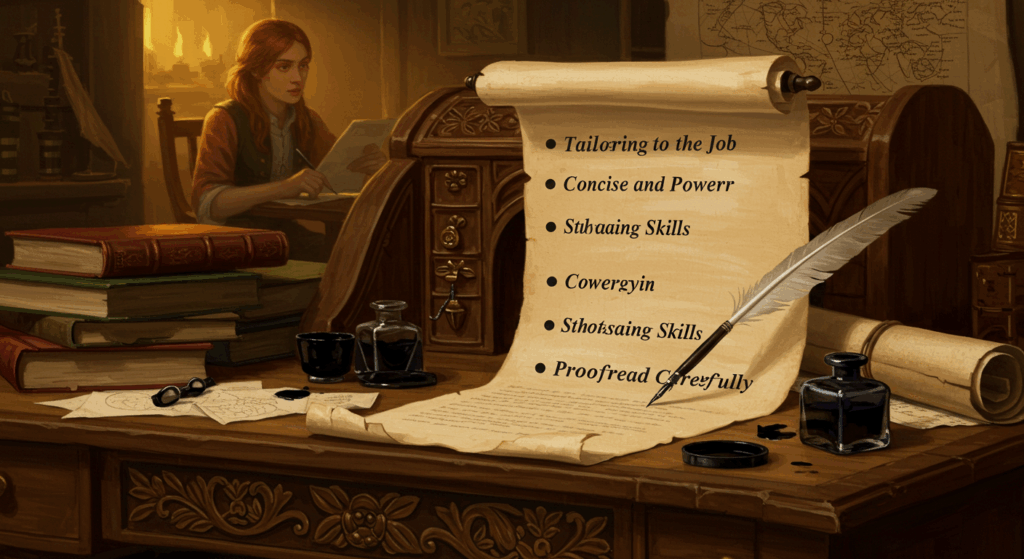We know that writing a cover letter can feel like trying to flirt on a dating app. You’re trying to be confident but not cocky, friendly but not weird, and you get about five seconds to stand out before someone swipes left—uh, I mean, hits “Next applicant.” If you’ve been staring at a blank doc like it’s a scary movie you’re not ready to watch, breathe. You don’t need to be Shakespeare. You just need to be clear, specific, and a little bit human.
This is your friendly, slightly chaotic, totally useful guide to create a cover letter that actually gets noticed. I’ll share practical tips and tricks, show effective techniques that hiring managers actually care about, and give you sample templates you can copy, paste, and tweak (ngl—this is the best part). We’ll keep the tone casual, slip in a few jokes, and still give you the real, grown-up advice that turns “meh” text into “yes, interview.”
Cool? Grab a coffee (or a bubble tea), open a new doc, and let’s build a cover letter you’re proud of.
Why a Cover Letter Still Matters (Even When They Say It’s “Optional”)
“Optional” is corporate for “you’ll look better if you do it.” A cover letter is your chance to connect the dots: who you are, why this role, and how you’ll help them win. Resumes show facts; cover letters tell a story. Together, it’s like the perfect playlist: resume is the track list, cover letter is the mood.
Real talk: not every recruiter reads every cover letter. But the ones who do? They’re looking for clarity, motivation, and proof that you “get” the role. If it takes you 15 minutes to tailor your letter and that moves you above a chunk of the pile, that’s a high-ROI move—higher than scrolling TikTok for the same 15 (no judgment, I do it too).
The Vibe You Want (And the Vibe to Avoid)
Aim for: warm, direct, specific.
Avoid: robotic clichés (“I am writing to express my interest…”), long lists of adjectives, and anything that screams “Copy-paste 2012.”
Imagine you’re texting a smart friend about why you’ll crush this role—then tidy up the grammar and add structure. Boom. That’s your voice.
The Anatomy of a Cover Letter (A Simple Map)
Think four parts. Short paragraphs. Light on fluff:
- Header & Greeting
Keep it clean: your name, contact info, date, manager’s name if possible, and the company’s name. Say “Hi [Name],” or “Dear [Name],” if you know it. If you don’t, “Hi Hiring Team,” is fine (way better than “To whom it may concern,” which sounds like a Victorian telegram). - Opening Hook
One or two sentences: why this company + what you bring. Give a mini-statemnent of value. Make it specific to them, not “I’m passionate about innovation.” (Who isn’t?) - Body (Proof Section)
Two short paragraphs or a paragraph + bullet points. Use effective techniques like achievements + metrics (increased X, reduced Y, launched Z). Tie your most relevant wins directly to the job description. - Close + Call to Action
One or two lines that show momentum. Drop a friendly “Thanks for your time” and, optionally, a quick P.S. line with a bonus result or portfolio link. P.S. lines get read—yes, even by busy people.
Tips and Tricks to Sound Like a Pro (Without Being Stiff)
1) Mirror Their Priorities (Not Their Exact Words)
Read the job posting and pick the top 3 themes. If they’re screaming “customer retention,” “data literacy,” and “cross-functional teamwork,” your letter should hit those, in that order. No keyword stuffing; just smart echoing.
2) Lead With Outcomes, Not Tasks
Anyone can say “responsible for managing social campaigns.” Yawn. Try: “Grew Reels/TikTok reach from 12K to 80K in 4 months, lifting referral traffic by 31%.” That’s proof. And yeah, if you don’t have exact numbers, estimates are okay (be honest; ranges work).
3) Keep It Under 300 Words (ish)
Short wins. If a recruiter opens your letter on a phone (which happens), they’ll skim. Two-thirds of a screen is perfect. If you’re mid-career with lots to share, you can go longer—just don’t ramble.
4) Use a “T-Format” or Bullets for Clarity
One column: what they need. Other column: how you match. Or do 3–4 bullet points with crisp achievements. Effective techniques = anything that helps skimmers get your value in seconds.
5) Add a P.S.
It’s weirdly powerful. P.S. is like bonus content—an award, a quick link, or an extra stat that suypports your case. Easy win.
6) Don’t Recycle One Letter
Personalize at least 20–30%. Mention something real: a product update, a mission statement that actually resonated, or a customer story you saw on their blog. Light personalization > generic fluff.
7) Don’t Over-Explain Gaps
One sentence and move on: “Took a 6-month sabbatical to care for family; now energized to return to customer success.” Keep it clean. The goal is forward energy.
8) Proofread, but Keep the Personality
A mini “you” matters. “I’d love to help you turn more trial users into superfans” is fine. Just avoid slang that might confuse (“no cap” is cute but risky).
Effective Techniques You Can Steal (I mean, “adopt”)
The PAR Method (Problem–Action–Result)
Pick a problem that matches the job, describe what you did, show the result. It’s the Swiss Army knife of storytelling.
Example:
Problem: churn rising among SMB clients.
Action: designed a monthly check-in + education series.
Result: churn down 18% in one quarter, NPS up 11 points.
The Mini-Case Study
One paragraph that recreates a specific situation. This technique works great for roles in sales, ops, marketing, and product.
Template:
“When [company] faced [context], I led [initiative], partnering with [teams/tools]. We shipped [deliverable] in [time frame], which produced [metric]. I’d bring that same energy to [Company]’s [team/goal].”
T-Format Snapshot
List three job requirements on the left, your matching proof on the right. Clean, visual, scannable.
Example:
- Lifecycle email → boosted 90-day retention from 48% to 59% with onboarding drip
- SQL basics → built a cohort report to identify churn-prone segments
- Cross-functional → partnered with Product to test in-app nudges (result: +12% feature adoption)
The “One Big Thing” Hook
Open with your strongest result, then connect it to their mission. If you’ve got a mic-drop stat, don’t bury it.
Example:
“In 2024, I launched a creator partnership program that added $420K ARR in 6 months. I’d love to bring that scrappy growth playbook to your ecosystem.”
The “Why You” Sentence
Every letter needs one line that explains why this company. Keep it specific and simple: “Your recent shift from one-time to subscription pricing is smart. I’ve helped run that transition and can bring playbooks for churn prevention + cross-sell.”
How to Personalize Without Spending All Night (You’re Busy, I Know)
- Skim the About page for mission/values.
- Scroll LinkedIn for posts from team leaders (look for priorities).
- Glance at product updates or a blog post—mention something real.
- Read a few Glassdoor reviews (grain of salt) to catch recurring themes.
- Check the job description for repeated phrases—mirror the idea, not the exact phrase.
Two sentences of good personalization beats three paragraphs of generic noise.
Sample Templates (Copy, Paste, Personalize)
Use these sample templates as your starting point. They’re short, chattier than boring corporate letters, and built for easy tailoring. Don’t forget to plug in your examples and numbers.
Template 1: General Professional (Short + Punchy)
Hi [Hiring Manager Name],
I’m excited about the [Role] at [Company]—especially because you’re focused on [specific company priority]. In my last role at [Previous Company], I [what you did] and delivered [result: metric, time frame]. That experiemce maps well to your need for [skill area mentioned in JD].
Highlights that match your posting:
- [Skill/Responsibility] → [Achievement with number if possible]
- [Tool/Process] → [Outcome or impact]
- [Collaboration/Soft Skill] → [Brief example]
I work fast, I’m practical with data, and I keep teams aligned without the drama. I’d love to help [Company] hit [specific team goal or metric]. Thanks for considering my application—happy to share more detail or a quick sample of my work.
Best,
[Name]
[LinkedIn] | [Portfolio or GitHub] | [Contact]
P.S. I led a [mini-project] that improved [metric] by [X%]; here’s a quick overview: [link].
Template 2: Career Switcher (Transferable Skills On Display)
Hi [Hiring Manager Name],
I’m applying for [Role] because the overlap between my past work in [Old Field] and your needs in [Target Field] is stronger than it looks. In [Old Field], I owned [relevant tasks], used [tools], and delivered [result]. Those same muscles—prioritization, stakeholder management, and data-driven decisions—will help me contribute quickly at [Company].
What I bring:
- [Transferable Skill] → Example: [brief achievement]
- [Tool/Method the JD Mentions] → [how you’ve used it]
- [Soft Skill/Collaboration] → [quick context]
I’ve completed [course/cert/project] to get hands-on in [Target Field], and I’m ready to add value on day one. Would love to chat about how I can help your team hit [specific team OKR].
Thanks for your time,
[Name]
[Portfolio or Project Links]
P.S. Here’s a brief case study (2 min read) on how I [did X] to achieve [Y result]: [link].
Template 3: Early Career / No Experience
Hi [Hiring Manager Name],
I’m a recent [Graduate/Bootcamp Alum] excited about [Role] at [Company]. I’ve built small but real projects that match your stack—like [project], where I [what you did] and [result]. I thrive in fast feedback loops and love shipping things people actually use.
Quick wins I can bring:
- [Tool/Language] → Built [feature], improved [metric or user feedback]
- [Teamwork] → Collaborated with [who] to [what]
- [Learning] → Completed [course/cert] to go deeper in [topic]
I’d be grateful for the chance to contribute to [Company]’s [team mission]. Thank you for considering me.
Best,
[Name]
[GitHub/Portfolio] | [LinkedIn]
Template 4: Referral-Based
Hi [Hiring Manager Name],
[Referrer Name] suggested I reach out about the [Role] at [Company]. We worked together on [project/company], and they thought my experience in [skill area] would be a fit. At [Previous Company], I [action] and delivered [result], which lines up with your focus on [priority from JD].
A few relevant highlights:
- [Achievement 1 with metric]
- [Achievement 2 with metric]
- [Tool/Process] you mentioned → [how I’ve used it]
Happy to share more details or do a quick call. Thanks for considering my application.
Best,
[Name]
[Contact] | [LinkedIn]
P.S. Here’s a short portfolio sample that mirrors your use case: [link].
Template 5: Product/Design (Portfolio-Forward)
Hi [Hiring Manager Name],
Your team is building [product area or feature], and that got me excited—especially the push toward [specific UX/product principle]. I’ve shipped projects that solved similar problems, like [Project], where we [what changed] and saw [quantified impact].
What I’d bring to [Company]:
- Problem framing: ran [research method], uncovered [insight]
- Execution: shipped [feature], improved [metric]
- Collaboration: partnered with [engineering/marketing/sales] to [result]
Portfolio: [link] (see case studies 1 & 3 for closest parallels). Would love to support your roadmap.
Thanks,
[Name]
P.S. I’m especially interested in improving [specific part of their product]—happy to share a 1-page teardown if helpful.
Make It ATS-Friendly (But Human-Readable)
Yes, some systems scan your letter. Keep it in standard formatting (no weird columns), and include a few job-specific terms naturally. Use the role title (“Customer Success Manager,” “Frontend Developer”) in your opening line. Don’t overdo it—effective techniques should serve humans first, software second.
Mini checklist:
- Save as PDF unless they say otherwise.
- Naming:
FirstName-LastName-CoverLetter-Company.pdf - Use the same header style as your resume for a cohesive look.
- Keep fancy graphics for your portfolio, not the cover letter.
Metrics: Where to Find Them If You Don’t Track Everything (yet)
No numbers? You probably have some you forgot.
- Marketing: conversions, CTR, engagement, email open rates, follower growth, CAC changes.
- Sales: quota %, close rate, average deal size, time to close, pipeline growth.
- Ops: error rate reduction, cycle time improvements, cost savings.
- Support/CS: CSAT, NPS, time to first response, ticket backlog reduction, retention.
- Engineering: performance gains, build times, bug reductions, on-call incidents.
Even directional is okay: “reduced by ~15%,” “grew by ~1.5x,” or “moved adoption from low-single digits to mid-teens.” Honest ranges > suspiciously exact numbers you can’t explain.
Tone and Word Choice: Tiny Tweaks, Big Upgrade
Swap these:
- “I am writing to apply for” → “I’m excited about the [Role] because…”
- “Responsible for” → “I led/owned/implemented/built…”
- “Team player” → “Partnered with X/Y to do Z”
- “Hard worker” → “Shipped [deliverable] in [timeframe], improving [metric]”
- “Passionate” (alone) → “I care about [user/problem] and have done [concrete thing]”
These are small but powerful tips and tricks that make you sound capable, not generic.
Common Mistakes (Don’t Do These, Please)
- Writing a resume in paragraph form. Your cover letter isn’t a block of every job you’ve had. Curate.
- Being vague. “I’m a team player with strong communication skills” says nothing concrete.
- Misnaming the company or role. Triple-check. Seriously.
- Sounding desperate. You’re offering value, not asking for a favor.
- Apologizing for gaps/changes. Don’t shrink. Briefly address and pivot to strengths.
- Over-formatting. Keep it clean—no rainbow fonts or clip art (this isn’t MySpace).
A Few Real-Life Examples (Mini Snippets You Can Borrow)
Ops Coordinator → Ops Manager:
“I standardized our returns workflow across 3 warehouses, cutting average processing time from 5.1 days to 2.8. At [Company], I’d map your current lifecycle, identify choke points, and run the same play—faster.”
Creator Partnerships → Community Lead:
“I built relationships with 40 mid-tier creators, doubling content volume without doubling costs. Community is about trust; I’ll bring the same long-game energy to your ambassador program.”
Junior Developer → Frontend Engineer:
“I shipped a React refactor that reduced initial load by 41% (Lighthouse 72 → 92). Your emphasis on performance-first UI is exactly my vibe.”
Notice the pattern? Quick context → action → impact. That’s the heartbeat of effective techniques for cover letters.
Formatting Basics (Because Visuals Matter)
- Font: a clean sans serif (Inter, Calibri, Arial) at 11–12 pt.
- Margins: 1 inch; 0.75 if you need space.
- Length: 200–350 words for most folks.
- Spacing: single with a line between paragraphs.
- Links: 1–2 to portfolio/LinkedIn; keep them short/clean.
You’re signaling “I’m thoughtful and organized” before they read a word.
Quick Personalization Script (Copy This Workflow)
- Paste Template 1 into a doc.
- Spend 5 minutes skimming the company site + JD; write down 3 priorities.
- Swap in a strong opening about why them.
- Add 3 bullet wins mapped to their top 3 needs.
- Add a P.S. with a link or stat.
- Proofread out loud (yes, really).
- Save, name, and send with your resume.
Total time: like, one playlist (30–40 minutes). Faster once you’ve done a few.
Advanced Tips and Tricks (For Extra Polish)
- Use a value prop tagline under your name in the header (optional):
“Lifecycle Marketer | Retention, Onboarding, Win-Back.” - Address an objection if it keeps popping up: “While I haven’t used [your tool], I’ve led adoption of similar platforms—spin-up is fast for me.”
- Add a micro-CTA beyond “thanks”: “If helpful, I can send a 1-page plan for your Q4 launch.”
- Borrow the brand tone lightly—if they’re playful, you can be playful. If they’re buttoned-up fintech, keep it crisp.
- Close loops in your letter: If you open with “I’ve grown retention,” show one bullet that proves it. Neat, satisfying, believable.
Extra Sample Templates (Niche Use Cases)
Template 6: Customer Success / Support
Hi [Hiring Manager Name],
I love how [Company] prioritizes long-term customer health over short-term tickets. That’s my approach too. At [Previous Company], I launched a quarterly “health review” program that cut churn by [X%] and turned 3 at-risk accounts into case studies.
What I can do for you:
- Proactive playbooks: onboarding sequences + QBRs that drive adoption
- Voice-of-customer feedback: partnered with Product to ship 2 features from top requests
- Fast triage: reduced average first response from [X] to [Y]
I’d be excited to help your team deepen relationships and expand revenue the right way.
Thanks,
[Name]
Template 7: Data/Analytics
Hi [Hiring Manager Name],
Your job description calls for someone who can translate messy data into clear decisions. That’s my lane. I built a self-serve dashboard (dbt + BigQuery + Looker) that cut weekly reporting time from 6 hours to 45 minutes and uncovered a pricing anomaly worth ~$120K ARR.
If helpful, I can spin a quick sample analysis on your public data.
Best,
[Name]
Template 8: Short Email Cover Note (When They Ask for “Email Only”)
Subject: Application — [Role], [Your Name]
Hi [Name],
Excited about [Role] at [Company]. In my last role, I [achievement] that led to [result]. Here are two quick wins mapped to your needs:
• [Requirement] → [Outcome]
• [Requirement] → [Outcome]
Resume + portfolio attached. Thanks for your time!
[Name] | [Phone] | [LinkedIn]
How to Reuse Templates Without Sounding Like a Robot
- Keep the skeleton the same.
- Swap out the opening two lines + the three bullets.
- Update the P.S. to match their world.
- If you’re applying to 10 roles in the same niche, keep a bank of 12–15 bullets you rotate. That’s a time-saver and still personal.
These tips and tricks help you scale without losing authenticity.
A Note on AI Help (👀 meta moment)
Using AI to brainstorm bullets or tighten a sentence? Chill, that’s normal now. Just make sure the numbers are yours, the voice sounds like a person (you), and the claims are true. If a sentence feels too glossy, make it plainer. The goal isn’t to sound like a robot who went to finishing school; it’s to sound like a competent, decent human who can deliver.
Quick One-Page Checklist (Pin This)
- Does your opening say why them + your biggest win?
- Do you have 2–4 specific achievements that map to the JD?
- Are there numbers (even rough) in at least one bullet?
- Is the tone professional but human?
- Did you include a P.S. with a link or extra stat?
- Is it clean and short (ideally 200–350 words)?
- Filename and links good? (No “final_v7_REAL_final.pdf,” pls.)
- Sent as PDF unless they asked otherwise?
If you nodded yes to most of these, you’re good.
Tiny Edits That Make a Big Difference (Before You Hit Send)
- Read it out loud. Anywhere you stumble, edit.
- Check company/manager names (twice).
- Remove any brag that you wouldn’t say on a Zoom call.
- Replace 1–2 generic words with specifics: “improved retention” → “improved 90-day retention.”
- Add a little humanity: “I’d love to help you turn more trial users into loyal fans.”
These are simple effective techniques that keep your letter sharp and believable.
Final Words (Yes, You Can Do This)
Writing a cover letter doesn’t have to feel like homework from a teacher you’re scared of. You’re just connecting your wins to their needs—clearly, briefly, kindly. Use the sample templates, plug in your specifics, and you’re already 80% there. The rest is trimming fluff, adding proof, and hitting send without overthinking it (easier said than done, I know).
If you remember nothing else from this whole post, remember this: short, specific, sincere. That’s it. That’s the game.
You’ve got this. Seriously.
Now go draft your letter, sprinkle in these tips and tricks, apply those effective techniques, grab a sample template, and send it. Then treat yourself to something little—coffee, a walk, an episode of your comfort show. Momentum is a skill. Build it.
Your move: open a doc, paste a template, write the first two sentences. Hit save. Five minutes. Let’s go.









